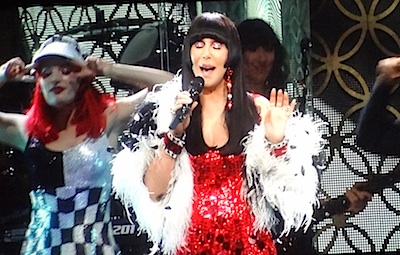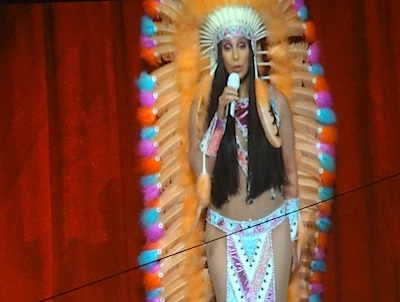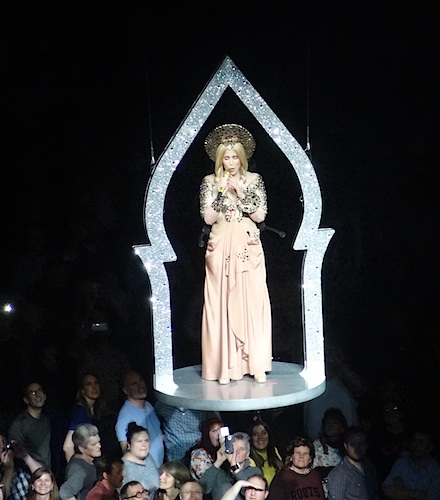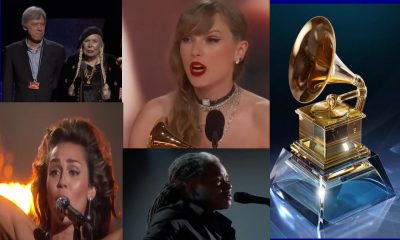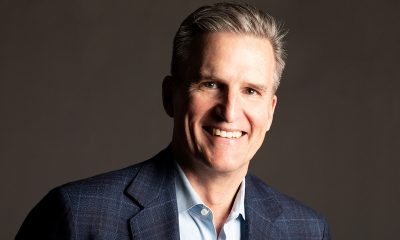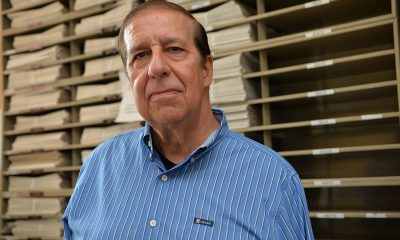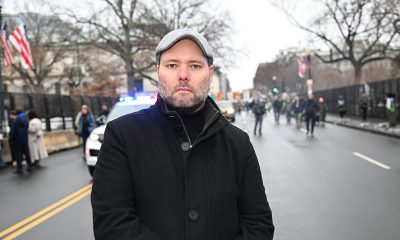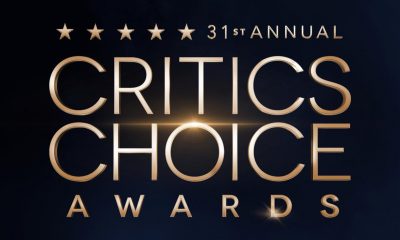a&e features
Gays out in force for Cher
Diva’s ‘farewell farewell’ show jells after opening night kinks worked out

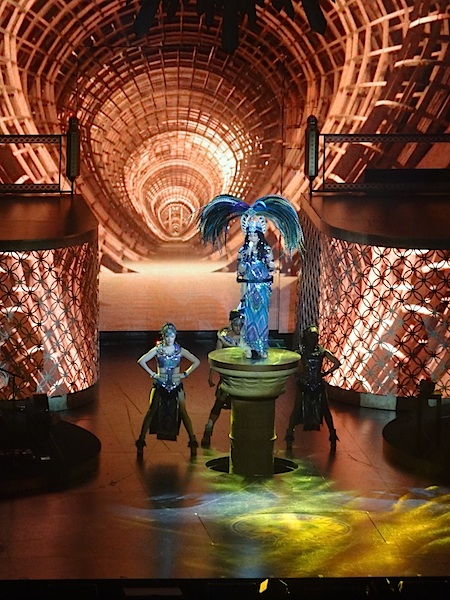
(Washington Blade photo by Brian Walmer)
By BRIAN WALMER
Special to the Blade
Friday night gay and pop culture icon Cher brought her current “Dressed to Kill Tour” to the Verizon Center for an evening filled with hits, new songs and lots of glam.
The tour was announced shortly after the release of her first album in 10 years, “Closer to the Truth,” and fans were beyond thrilled. In 2005, Cher ended her nearly three-year “Farewell Tour” at the Hollywood Bowl and said that was it as far as touring was concerned.
In 2008, the diva did an elaborate three-year run at the Coliseum in Vegas and while she loved the show, she had said in a few interviews she wasn’t crazy over the crowds and missed going out playing for her fans.
Nearly three years later here we are and Cher is out on the road again gaining rave reviews since the start of the tour in Phoenix two weeks ago. After some opening night mishaps (ill-fitting costumes, flubbed lyrics and missed cues) it seems the tour is now off and running like a well-oiled machine.
“I’m on my way out there. You better be good too or as my mother would say, ‘Cher don’t make me get off this couch,’ ” came Cher’s voice unexpectedly before the start of the show turning the packed arena into a frenzy. Young, old, gay, straight, black, white, everyone turned out for Cher’s (this time she supposedly means it) final tour. Fans dressed in tour shirts sporting the legend’s face, others opted for home-made shirts that showcased song titles and the tour logo. Surprisingly, I didn’t see one Cher look a-like roaming the arena.
Starting the show with a montage of clips, the white curtain dropped and there she stood atop a giant pedestal dressed in a massive feather headpiece and looking every bit like an Egyptian goddess belting out “Woman’s World.” Disappearing briefly, she remerged (sans headpiece) performing “Strong Enough” from 1998’s “Believe” before chatting with the crowd.
“My life’s goal is to make you happy,” she said. “Who cares if I stand on top of a 20-foot high pillar, standing on a space the size of a desert spoon singing out my lungs before plunging into the ground; these are my thoughts,” she told the audience before sipping Dr. Pepper and going on a rant about her love of Dr. Pepper and how the only thing they’ve given her is a cooler and a six-pack.
During her opening monologue which she said wasn’t as scripted as her previous tours, she went off on a variety of topics. “Gaga doesn’t do that,” she said. “I’d rather stand and talk than have some chick vomit on me. Call me old fashioned. I’m just that funny kind of gal.”
Story topics ranged from her aunt who was the first woman in Little Rock to have shock treatment, her near arrest in Nashville and when she got toilet paper stuck to her fingernail on the opening night of the tour. Despite all the talking and fun you could tell she was having with the audience, she closed her monologue with the news that this is her “Farewell Farewell Tour” — but not without giving a few winks.
After a brief video interlude that turned the Verizon Center into a stormy red inferno Cher emerged from the floor of the stage riding a chandelier belting out “Dressed To Kill” in a sheer body suit with a flowing black train.
Next up was Cher from the Sonny & Cher days. After a video montage played clips of the famous couple to the tunes of “Little Man” and “All I Ever Need Is You,” the set turned to black and white and dancers emerged to the opening of the “The Beat Goes On” before being joined onstage by Cher dressed in a sparkly red mini skirt and black-and-white feather boa. After finishing the tune, the icon that’s been a staple of pop culture since the ’60s told the crowd since this is her last time out, she was going to do something she never thought she’d be able to do.
“It took me forever to be able do this and frankly I didn’t think I would be able to do this” she told the crowd before doing a video duet of “I Got You Babe” with her late partner and husband. Despite lots of ups and downs in their relationship, they were arguably America’s favorite entertaining duo and seeing her perform again with him was touching.
Next up was a group of circus-attired dancers and a gypsy garbed-Cher to sing a medley of ’70s hits like “Gypsies, Tramps and Thieves,” “Dark Lady” and “Half-Breed,” which she sang while wearing an elaborate feathered headdress.
After a montage of acting clips, she came back out to sing “Welcome to Burlesque” as Tess, her character from “Burlesque,” the 2010 bomb she made with Christina Aguilera. She said “You Haven’t Seen the Last of Me,” which she sang next, was one of the hardest she ever tackled.
“We call this song ‘the beast’ because sometimes I made it through and sometimes I don’t … and I’m very brave. The few times I made it through, it was quite wonderful” It was probably just suspense-building banter as she sang it powerfully and near flawlessly.
Two male dancers performed acrobatic stunts before Cher entered the stage in a giant Trojan horse dressed in gold armor belting out fan favorite “Take It Like a Man” from her new album.
Steering the show in a stripped-down direction, Cher entered the stage in simple black slacks and an off-the-shoulder black top performing “Walking In Memphis” after a video played showing her love of Elvis and seeing him with her mom as a kid. In between sips of Dr. Pepper she told the crowd she had foot surgery and called herself a “crazy bitch” at the thought of launching a tour.
Since this is the “Farewell Farewell Tour,” she did “Just Like Jesse James,” a song she has admitted she doesn’t like and reiterated that sentiment again before performing it for the D.C. crowd. Moving onto a song she does like, she performed her favorite, “Heart of Stone.”
Long time background vocalist for Cher, Stacy Campbell, performed “Bang Bang” with new Cher recruit, Nikki Tillman against a video backdrop of past performances of the song.
To the opening of the ’80s hit “I Found Someone,” Cher entered center stage looking just as she did then — big hair, leather jacket, knee high boots and sheer peek-a-boo body suit. Removing the jacket, Cher belted out one of her signature hits, “If I Could Turn Back Time” prancing across the stage bringing the crowd to its feet.
“Believe” was presented as a crowd singalong. She sang the monster hit while wearing a revealing glittery outfit with a red heart on the chest.
“I Hope You Find It” was the encore, sung with Cher standing on a small platform that flew above the crowd letting fans everywhere get an up close view of the icon before she landed back onstage and called it a night nearly two hours after the show started.
Throughout the show, Cher’s voice was top notch and you could tell 99.9 percent of it was live. It seemed she enjoyed shaking up her set list a bit and added some songs that were a bit more challenging than before. Though its early in the tour, not once did she seem like she was going through the motions. Instead of just talking during the opening monologue and the sit down portion of her show like previous tours, she chatted and joked with the crowd between numbers and made the arena tour feel a bit more intimate and less staged.
The interludes between numbers worked well to blend the songs and visuals so you felt like you weren’t waiting long between costume changes. Speaking of costume changes, while Bob Mackie opted out of doing the new tour, some of his outfits were there, rehashed from previous tours along with new outfits from Hugh Durant. You really couldn’t tell whose outfits were whose and Cher did a great job blending all the elements together so everything ran like a big Broadway show.
If this is truly Cher’s last tour, it’s one hell of a last hurrah. It’s obvious this was a labor of love and I don’t think I ever saw Cher have this much fun on stage. A lot of time was spent making this production one that would be entertaining and also one that pushed Cher to the limits.
Pat Benatar opened with her husband, Neil Giraldo (the Blade interviewed him here). They’re celebrating their 35th anniversary together.
Cher apparently is a fan of Benatar’s and performed the rocker’s “Love Is a Battlefield” during her 1992 “Love Hurts Tour” and the first leg of her 2008 Vegas show. For Benatar/Giraldo’s hour-long set, they focused solely on hits and turned the Verizon Center into one big karaoke parlor. Pat’s voice is still as strong today as it was then and that sexy, husky growl is still there as she belted out hits such as “Love is a Battlefield,” “Hit Me With Your Best Shot” and “Heartbreaker.” I’ve seen Pat three times before this show and while I loved each time, I really enjoyed the extra production that went into opening for Cher. The band sounded fuller, backing vocals were added and Pat’s voice was front and center instead of blending into the mix. If you’re reading this Pat, a new album would be fantastic! The musical duo performs with Cher until April 14. Cyndi Lauper takes over thereafter.
SET LIST:
Pat Benatar:
Shadows of the Night
All Fired Up
Invincible
We Live For Love
Promises In The Dark
We Belong
Hit Me With Your Best Shot
Love Is a Battlefield
ENCORE:
Let’s Stay Together
Heartbreaker/Ring of Fire
Cher:
Woman’s World
Strong Enough
Dressed to Kill
The Beat Goes On
I Got You Babe
Gypsys, Tramps & Thieves
Dark Lady
Half-Breed
Welcome to Burlesque
You Haven’t Seen the Last of Me
Take It Like a Man
Walking in Memphis
Just Like Jesse James
Heart of Stone
Bang Bang (My Baby Shot Me Down) (performed by background vocalists)
I Found Someone
If I Could Turn Back Time
Believe
I Hope You Find It
a&e features
Queer highlights of the 2026 Critics Choice Awards: Aunt Gladys, that ‘Heated Rivalry’ shoutout and more
Amy Madigan’s win in the supporting actress category puts her in serious contention to win the Oscar for ‘Weapons’

From Chelsea Handler shouting out Heated Rivalry in her opening monologue to Amy Madigan proving that horror performances can (and should) be taken seriously, the Critics Choice Awards provided plenty of iconic moments for queer movie fans to celebrate on the long road to Oscar night.
Handler kicked off the ceremony by recapping the biggest moments in pop culture last year, from Wicked: For Good to Sinners. She also made room to joke about the surprise hit TV sensation on everyone’s minds: “Shoutout to Heated Rivalry. Everyone loves it! Gay men love it, women love it, straight men who say they aren’t gay but work out at Equinox love it!”
The back-to-back wins for Jacob Elordi in Frankenstein and Amy Madigan in Weapons are notable, given the horror bias that awards voters typically have. Aunt Gladys instantly became a pop culture phenomenon within the LGBTQ+ community when Zach Cregger’s hit horror comedy released in August, but the thought that Madigan could be a serious awards contender for such a fun, out-there performance seemed improbable to most months ago. Now, considering the sheer amount of critics’ attention she’s received over the past month, there’s no denying she’s in the running for the Oscar.
“I really wasn’t expecting all of this because I thought people would like the movie, and I thought people would dig Gladys, but you love Gladys! I mean, it’s crazy,” Madigan said during her acceptance speech. “I get [sent] makeup tutorials and paintings. I even got one weird thing about how she’s a sex icon also, which I didn’t go too deep into that one.”
Over on the TV side, Rhea Seehorn won in the incredibly competitive best actress in a drama series category for her acclaimed performance as Carol in Pluribus, beating out the likes of Emmy winner Britt Lower for Severance, Carrie Coon for The White Lotus, and Bella Ramsey for The Last of Us. Pluribus, which was created by Breaking Bad’s showrunner Vince Gilligan, has been celebrated by audiences for its rich exploration of queer trauma and conversion therapy.
Jean Smart was Hack’s only win of the night, as Hannah Einbinder couldn’t repeat her Emmy victory in the supporting actress in a comedy series category against Janelle James, who nabbed a trophy for Abbott Elementary. Hacks lost the best comedy series award to The Studio, as it did at the Emmys in September. And in the limited series category, Erin Doherty repeated her Emmy success in supporting actress, joining in yet another Adolescence awards sweep.
As Oscar fans speculate on what these Critics Choice wins mean for future ceremonies, we have next week’s Golden Globes ceremony to look forward to on Jan. 11.
a&e features
Looking back at the 10 biggest A&E stories of 2025
‘Wicked,’ Lady Gaga’s new era, ‘Sexy’ Bailey and more

Although 2025 was a year marked by countless attacks on trans rights and political setbacks, the year also saw brilliant queer artists continuing to create art. From Cannes and Sundance Award winners now vying for Oscar consideration to pop icons entering new stages of their careers, queer people persevered to tell their stories through different media.
With the state of the world so uncertain, perhaps there’s no more vital time to celebrate our wins, as seen through some of this year’s top pop culture moments. While there’s no collection of 10 stories that fully encompass “the most important” news, here are some events that got the gays going:
10. ‘Mysterious Gaze of the Flamingo’ wins big at Cannes

The Cannes Film Festival has become a crucial start for films hoping to make their way to the Oscars, and first-time director Diego Céspedes won the top Un Certain Regard prize for his intimate western “The Mysterious Gaze of the Flamingo.” The film is set in the ‘80s and is intended as an allegory for the AIDS epidemic. Seeing a film that unpacks vital queer history win one of the most coveted awards at Cannes has been a huge point of pride in the independent filmmaking community.
Since the film bowed at Cannes, it has been selected as Chile’s Oscar entry in the Best International Feature race. Speaking with The Blade during the film’s AFI Fest run in October, Céspedes said: At first, I was kind of scared to have this campaign position in the times that we’re living [in] here. But at the same time, I think the Oscars mean a huge platform — a huge platform for art and politics.”
9. ‘The Last of Us’ returns for an even gayer season 2
While the first season of The Last of Us gave us one of TV’s most heartbreaking queer love stories in the episode “Long, Long Time,” Season 2 doubled down on its commitment to queer storytelling with the blossoming relationship between Ellie (Bella Ramsey) and Dina (Isabela Merced). The show expanded on the pair’s relationship in the original video game, making it perhaps the central dynamic to the entire season. That unfortunately came with more homophobic backlash on the internet, but those who checked out all the episodes saw a tender relationship form amid the show’s post-apocalyptic, often violent backdrop. For their performance, Ramsey was once again nominated for an Emmy, but Merced deserved just as much awards attention.
8. ‘Emilia Pérez’ sparks controversy
Jacques Audiard’s genre-bending trans musical “Emilia Pérez” proved to be an awards season juggernaut this time last year, winning the Golden Globe for Best Musical/Comedy. But when the lead star Karla Sofia Gascón’s racist, sexist, and homophobic old tweets resurfaced, the film’s Oscar campaign became a tough sell, especially after Netflix had tried so hard to sell Emilia Pérez as the “progressive” film to vote for. Mind you, the film had already received significant backlash from LGBTQ+ audiences and the Mexican community for its stereotypical and reductive portrayals, but the Gascón controversy made what was originally just social media backlash impossible to ignore. The only person who seemed to come out of the whole debacle unscathed was Zoe Saldaña, who won the Oscar for Best Supporting Actress over Ariana Grande.
7. ‘Sorry, Baby’ establishes Eva Victor as major talent
Back in January at the Sundance Film Festival, Eva Victor (known by many for her brand of sketch comedy) premiered their directorial debut “Sorry, Baby” to rave reviews, even winning the Waldo Salt Screening Award. Victor shadowed Jane Schoenbrun on the set of “I Saw the TV Glow,” and seeing Victor come into their own and establish such a strong voice immediately made them one of independent cinema’s most exciting new voices. A memorable scene in the film sees the main character, Agnes (played by Victor), struggling to check a box for male or female, just one example of how naturally queerness is woven into the fabric of the story.
Most recently, Victor was nominated for a Golden Globe for her performance in the film, and she’s represented in a category alongside Jennifer Lawrence (“Die My Love”), Jessie Buckley (“Hamnet”), Julia Roberts (“After the Hunt”), Renate Reinsve (“Sentimental Value”) and Tessa Thompson (“Hedda”). The film also received four Independent Spirit Award nominations overall.
6. Paul Reubens comes out in posthumous doc

While Paul Reubens never publicly came out as gay before passing away in 2023, the two-part documentary “Pee-wee as Himself” premiered back in May on HBO Max, giving the legendary comedian a chance to posthumously open up to the world. Directed by Matt Wolf, the documentary explores how Reubens found his alter ego Pee-Wee Herman and why he kept his private life private.
The documentary won an Emmy in the Outstanding Documentary or Nonfiction Special category and remains one of the most critically acclaimed titles of the year with a 100% Rotten Tomatoes score. Also worth noting, the National Geographic documentary Sally told the posthumous coming out story of Sally Ride through the help of her long-time partner, Tam O’Shaughnessy.
5. Lady Gaga releases ‘Mayhem’
Lady Gaga entered a new phase of her musical career with the release of Mayhem, her seventh album to date. From the frenzy-inducing pop hit Abracadabra to the memorable Bruno Mars duet featured on “Die With a Smile,” seeing Gaga return to her roots and make an album for the most die-hard of fans was especially rewarding after the underwhelming film releases of “House of Gucci” and “Joker: Folie à Deux.” Gaga has been touring with The Mayhem Ball since July, her first arena tour since 2018. She even extended her tour into 2026 with more North American dates, so the party isn’t stopping anytime soon. And Gaga is even set to make an appearance next May in “The Devil Wears Prada 2.”
4. Cynthia Erivo, Ariana Grande perform at the Oscars

While “Wicked: For Good” didn’t quite reach the heights of the first film, we will forever have Cynthia Erivo and Ariana Grande’s breathtaking live performance that opened the 97th Academy Awards. The pair sang a rendition of “Over the Rainbow,” “Home,” and “Defying Gravity,” paying proper homage to the original 1939 “Wizard of Oz.” Even non-Wicked fans can’t deny how magical and brilliantly staged this performance was. With both Erivo and Grande up for acting Oscars last year, they’re hoping to repeat success and make history with consecutive nominations. Either way, let’s hope there’s another live performance in the making, especially with two new original songs (The Girl in the Bubble and No Place Like Home) in the mix.
3. Indya Moore speaks out against Ryan Murphy
Indya Moore has consistently used social media as a platform for activism, and in September, posted a 30-minute Instagram live speaking out against “Pose” co-creator Ryan Murphy. Moore claimed that Murphy wasn’t being a true activist for trans people. “Ryan Murphy, we need you to do more. You need to address the racism, the violence, and the targeting of people on your productions, Ryan Murphy. You do need to make sure trans people are paid equally. Yes, Janet did the right thing,” Moore said. Murphy was also back in the headlines this year for the critically panned “All’s Fair” and the controversial “Monster: The Ed Gein Story” starring Laurie Metcalf and Charlie Hunnam.
2. Cole Escola wins Tony for Best Leading Actor
Few pop culture moments this year brought us together more than Cole Escola winning a Tony award for “Oh, Mary!” the Broadway show they created, wrote and starred in (we love a triple threat!) Escola made history by becoming the first nonbinary person to win a Tony in the leading actor category, and seeing them excitedly rush to the stage wearing a Bernadette Peters-inspired gown instantly became a viral social media moment.
The cherry on top of Escola’s major moment is the recent news that they are writing a Miss Piggy movie with Jennifer Lawrence and Emma Stone producing — news that also broke the internet for the better. We cannot wait!
1. Jonathan Bailey makes gay history as ‘Sexiest Man Alive’

The same year as his on-screen roles in blockbusters “Jurassic World Rebirth” and “Wicked: For Good,” Jonathan Bailey made history as the first openly gay man to be named People magazine’s “Sexiest Man Alive.” The fact that it took 40 years for an openly gay man to earn the title is a signifier of how far we still have to go with queer representation, and seeing Bailey celebrated is just one small step in the right direction.
“There’s so many people that want to do brilliant stuff who feel like they can’t,” he told PEOPLE, “and I know the LGBT sector is under immense threat at the moment. So it’s been amazing to meet people who have the expertise and see potential that I could have only dreamed of.” In 2024, Bailey founded the charity titled The Shameless Fund, which raises money for LGBTQ+ organizations.
a&e features
Your guide to D.C.’s queer New Year’s Eve parties
Ring in 2026 with drag, leather, Champagne, and more
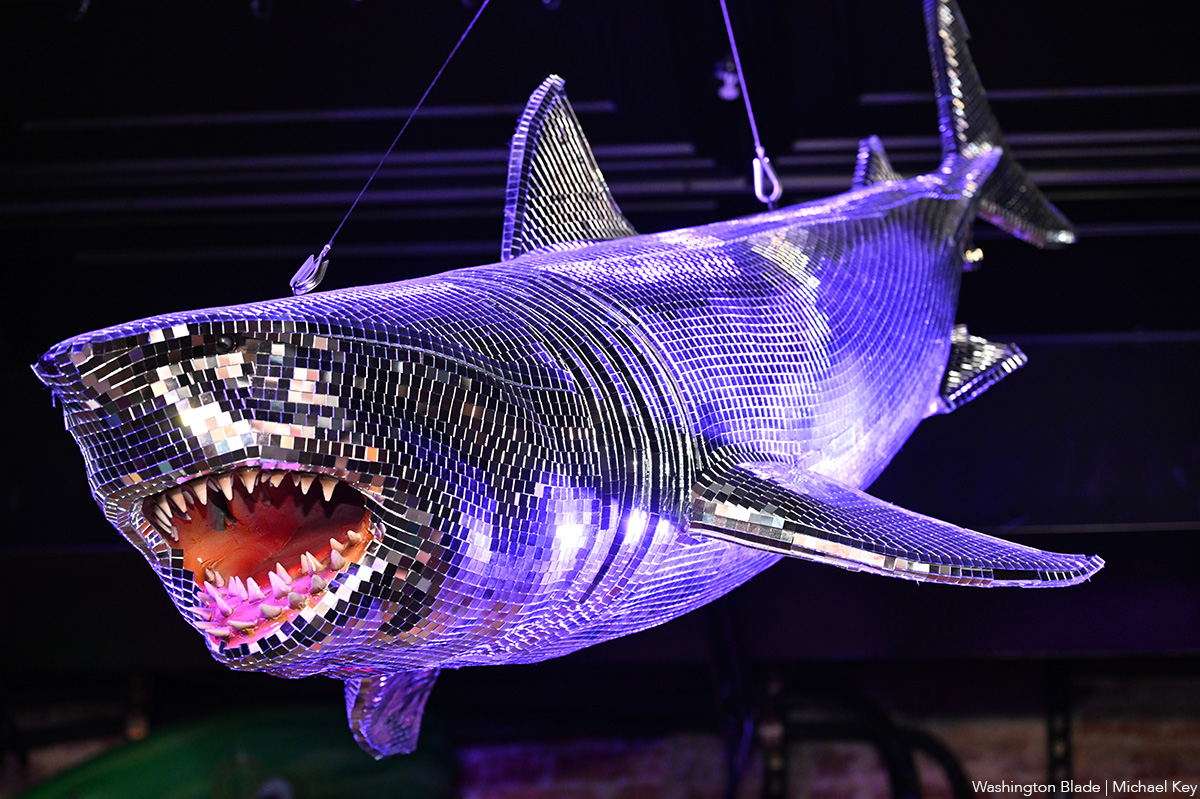
With Christmas in the rear view mirror, we can turn our attention to ringing in a much-anticipated New Year with a slew of local LGBTQ parties. Here’s what’s on tap.
Pitchers
This spacious Adams Morgan bar is hosting the “Pitchers’ Perfect New Year’s Eve.” There will be a midnight Champagne toast, the ball drop on the big screens, and no cover, all night long. The bar doesn’t close until 4 a.m., and the kitchen will be open late (though not until close). All five floors will be open for the party, and party favors are promised.
Trade
D.C.’s hottest bar/club combo is leaning into the Shark motif with its NYE party, “Feeding Frenzy.” The party is a “glitterati-infused Naughty-cal New Year’s Even in the Shark Tank, where the boats are churning and the sharks are circling.” Trade also boasts no cover charge, with doors opening at 5 p.m. and the aforementioned Shark Tank opening at 9 p.m.. Four DJs will be spread across the two spaces; midnight hostess is played by Vagenesis and the two sea sirens sensuously calling are Anathema and Justin Williams.
Number Nine
While Trade will have two DJs as part of one party, Number Nine will host two separate parties, one on each floor. The first floor is classic Number Nine, a more casual-style event with the countdown on TVs and a Champagne midnight toast. There will be no cover and doors open at 5 p.m. Upstairs will be hosted by Capital Sapphics for its second annual NYE gathering. Tickets (about $50) include a midnight Champagne toast, curated drink menu, sapphic DJ set by Rijak, and tarot readings by Yooji.
Crush
Crush will kick off NYE with a free drag bingo at 8 p.m. for the early birds. Post-bingo, there will be a cover for the rest of the evening, featuring two DJs. The cover ($20 limited pre-sale that includes line skip until 11 p.m.; $25 at the door after 9 p.m.) includes one free N/A or Crush, a Champagne toast, and party favors (“the legal kind”). More details on Eventbrite.
Bunker
This subterranean lair is hosting a NYE party entitled “Frosted & Fur: Aspen After Dark New Year’s Eve Celebration.” Arriety from Rupaul Season 15 is set to host, with International DJ Alex Lo. Doors open at 9 p.m. and close at 3 p.m.; there is a midnight Champagne toast. Cover is $25, plus an optional $99 all-you-can-drink package.
District Eagle
This leather-focused bar is hosting “Bulge” for its NYE party. Each District Eagle floor will have its own music and vibe. Doors run from 7 p.m.-3 a.m. and cover is $15. There will be a Champagne toast at midnight, as well as drink specials during the event.
Kiki, Shakiki
Kiki and its new sister bar program Shakiki (in the old Shakers space) will have the same type of party on New Year’s Eve. Both bars open their doors at 5 p.m. and stay open until closing time. Both will offer a Champagne toast at midnight. At Kiki, DJ Vodkatrina will play; at Shakiki, it’ll be DJ Alex Love. Kiki keeps the party going on New Year’s Day, opening at 2 p.m., to celebrate Kiki’s fourth anniversary. There will be a drag show at 6 p.m. and an early 2000s dance party 4-8 p.m.
Spark
This bar and its new menu of alcoholic and twin N/A drinks will host a NYE party with music by DJ Emerald Fox. Given this menu, there will be a complimentary toast at midnight, guests can choose either sparkling wine with or without alcohol. No cover, but Spark is also offering optional wristbands at the door for $35 open bar 11 p.m.-1 a.m. (mid-shelf liquor & all NA drinks).
-

 Sponsored5 days ago
Sponsored5 days agoSafer Ways to Pay for Online Performances and Queer Events
-

 District of Columbia4 days ago
District of Columbia4 days agoTwo pioneering gay journalists to speak at Thursday event
-

 Colombia3 days ago
Colombia3 days agoBlade travels to Colombia after U.S. forces seize Maduro in Venezuela
-

 a&e features4 days ago
a&e features4 days agoQueer highlights of the 2026 Critics Choice Awards: Aunt Gladys, that ‘Heated Rivalry’ shoutout and more

